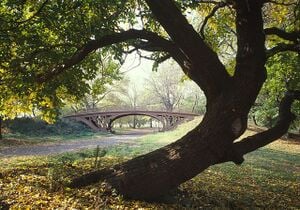
The aim of this page is to recognise, celebrate and encourage the self-empowerment of community agency networks (CANs) and community groups' activism for climate, environment and many other sustainability topics across New York City. It's an introduction to local networks, groups, and events. Other pages are shown in the navigation box towards the end of each page.
 From Asphalt to Inspiration: The Student-Led Transformation of America’s Schoolyards, reasonstobecheerful.world (Oct 04, 2024)
From Asphalt to Inspiration: The Student-Led Transformation of America’s Schoolyards, reasonstobecheerful.world (Oct 04, 2024)  The Towns Outsmarting Airbnb, reasonstobecheerful.world (Apr 02, 2024)
The Towns Outsmarting Airbnb, reasonstobecheerful.world (Apr 02, 2024)  ‘I thought we had more time’: how motherhood spurred a New Yorker’s fight against fossil fuels, theguardian.com (Dec 19, 2023)
‘I thought we had more time’: how motherhood spurred a New Yorker’s fight against fossil fuels, theguardian.com (Dec 19, 2023)
Networks and sustainability initiatives[edit | edit source]
- Sustainable South Bronx
- Change by Us NYC
- planyc, is an effort released by New York City Mayor Michael Bloomberg in 2007 to prepare the city for one million more residents, strengthen the economy, combat climate change, and enhance the quality of life for all New Yorkers. The Plan brought together over 25 City agencies to work toward the vision of a greener, greater New York. Since then, significant progress has been made towards the long-term goals set by the Plan.
- PlaNYC specifically targets ten areas of interest: Housing and Neighborhoods; Parks and Public Spaces; Brownfields; Waterways; Water Supply; Transportation; Energy; Air Quality; Solid Waste; and Climate Change.
- Over 97% of the 127 initiatives in PlaNYC were launched within one-year of its release and almost two-thirds of its 2009 milestones were achieved or mostly achieved. The plan was updated in 2011 and has been expanded to 132 initiatives and more than 400 specific milestones for December 31, 2013. (Wikipedia), GreeNYC
Ecovillages
- Ganas, "community started on Staten Island in 1979. The original founders came together to form a self-selected extended family based on an intention to care for each other while sharing the work, having fun and addressing whatever problems arise, together. Open minds make it possible to talk together and understand each other better. Ongoingly, they are learning how to cooperate, care for each other and share resources."
Community involvement[edit | edit source]
- BetaNYC, building a better tomorrow for all. "We are NYC's civic technology and open government vanguard. Since 2009, we have been leading elected officials to engage NYC's technology community, helping pass transformative open government legislation, and supporting NYC's civic oriented startups. We are America's largest civic technology and open government community."
- Participatory Budgeting in New York City
About New York City[edit | edit source]
New York, often called New York City or NYC, is the most populous city in the United States, located at the southern tip of New York State on one of the world's largest natural harbors. The city comprises five boroughs, each coextensive with a respective county. New York is a global center of finance and commerce, culture, technology, entertainment and media, academics and scientific output, the arts and fashion, and, as home to the headquarters of the United Nations, international diplomacy.
With an estimated population in 2023 of 8,258,035 distributed over 300.46 square miles (778.2 km2), the city is the most densely populated major city in the United States. New York City has more than double the population of Los Angeles, the nation's second-most populous city. New York is the geographical and demographic center of both the Northeast megalopolis and the New York metropolitan area, the largest metropolitan area in the U.S. by both population and urban area. With more than 20.1 million people in its metropolitan statistical area and 23.5 million in its combined statistical area as of 2020, New York City is one of the world's most populous megacities. The city and its metropolitan area are the premier gateway for legal immigration to the United States. As many as 800 languages are spoken in New York City, making it the most linguistically diverse city in the world. In 2021, the city was home to nearly 3.1 million residents born outside the U.S., the largest foreign-born population of any city in the world.
Past events[edit | edit source]
- May 11 -14, 2019 6th National Cultivating Community Composting Forum!
- Mar 4 - 10, 2019 Circular City Week
- May 4, 2014, TD Five Boro Bike Tour
- September 20 - 21, 2014, People's Climate March
- September 22 - 28, 2014, Climate Week NYC
- August 25, 2013, Ecofest
See also
- Topic overview: Community involvement, Networks
- US context: Community involvement USA
External links


